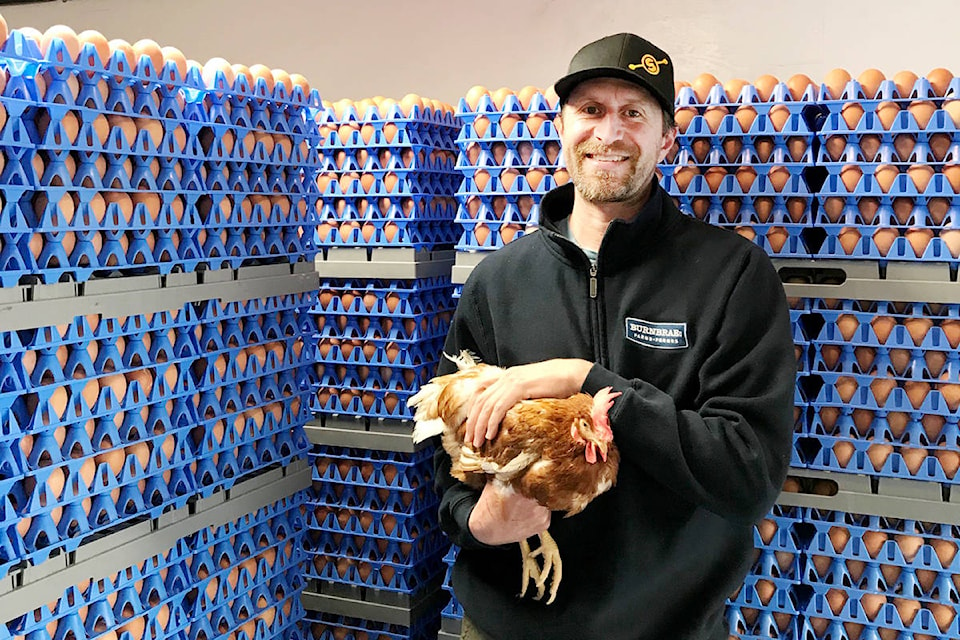Every day in Abbotsford, thousands of chickens lay thousands of eggs that end up in the stomachs of thousands of men women and children.
There’s nothing new in that.
So every day, Scott Janzen leaves his house, walks a few steps and enters his poultry barns where each morning about 26,000 eggs are laid.
There’s nothing new in that.
The basics look the same. And certain things remain unchanged, despite COVID-19.
But farms and farming families have also had to rethink and re-organize their lives since the arrival of a world-changing virus.
With one son out of work and another’s high school closed, Janzen, ironically, has more help to manage his thousands of free-range and free-run egg-layers.
“It hasn’t been super easy, and it hasn’t been totally horrible because we’ve been able to still be on the farm and still go outside and enjoy it, unlike some who are in a complex or an apartment,” he says.
It’s in Janzen’s other job – as a middle man tasked with keeping the eggs moving between producers and a major processing plant – where he has seen the greatest shift. But that shift has also enabled poultry farmers to help those who have been more negatively impacted by the virus.
• • • •
Chickens might not know the world is being upended by COVID-19, but the way people consume the eggs they produce has shifted considerably.
Demand at grocery stores has increased, but people are no longer eating eggs – and dishes containing eggs – in restaurants.
“The problem is we have a glut of small eggs,” says Janzen, who also works as a producer rep for Island Eggs. Those eggs, which are produced by younger chickens, would traditionally go to a “breaker” that uses them to make products for the restaurant industry. But that market has largely been closed, leaving producers trying to figure out what to do with those eggs.
You can probably see where this is going.
Janzen and his fellow farmers have found a way to help those facing even greater challenges by sending many of those eggs to Abbotsford’s food bank. Janzen got the ball rolling by buying back 300 dozen eggs. The plant, meanwhile, donated its services to grade and package the eggs.
“Another farmer in town said, ‘If they need more, I’m in,’ and [another said] ‘I’m in,’ and it just kind of snowballed from there,” Janzen says.
Those egg donations should continue until at least the end of June.
Janzen says farmers have been looking at ways to help.
“We still have jobs. Right now, we’re still making money, we’re still employed, so how can we help our community?”
• • • •
Like many of us, farmers are also missing each other.
“What [COVID-19] has changed is the community of farming,” Janzen says. “I’m a bit of a social guy too. I like the lunches, the coffees, like everyone else.”
So farmers are doing what many others are doing: using 21st century technology to talk about how an ancient occupation is dealing with a new threat.
So every Tuesday, around 15 people with a variety of agriculture jobs get on their computers to do the pandemic version of a coffee meeting.
Calling it a conference call may lend the call too much formality – “It’s more just a ‘Hey, what’s going on?’ ” Janzen says – but it allows farmers to stay in touch with one another, keep abreast of developments and just enjoy each others’ company.
“It’s been a learning curve, but I think they’ve kind of enjoyed it.”
Janzen is a social guy. But he also has a unique perspective on social isolation, the risks of not controlling the COVID-19 outbreak, and the long-term payoff of subjecting oneself to short-term isolation.
In 2017 and again in 2018, Janzen self-isolated for more than a month while undergoing treatment for multiple sclerosis, an autoimmune disease with a range of symptoms
“I’ve gone through the social isolation before, so it’s a little different for me. I went five/six weeks with watching Judge Judy – which is terrible – and not going to the barn at all. So I kind of understood what self-isolation was.
“From a health standpoint, I’ve actually felt better in the last year and a half doing the treatment that I did, than the three years before that,” he says. “For me it’s still been a fairly positive experience – I always bring that back in my life when I think: ‘Ugh!’ ”
During such moments, Janzen says he asks himself: “Where were you four years ago/five years ago?”
“I’m going: You know, this isn’t so bad. I can get up, I can go to work, I can work and all that stuff that MS can take from you. I’m doing good. Obviously, we try to protect ourselves because I will have a lower immune system than someone else … but we’ve been healthy, we’ve been good.”
Do you have something to add to this story, or something else we should report on? Email:
tolsen@abbynews.com
